Summer vacations are winding down and the annual ritual for parents buying school supplies for the kids is underway, but maybe it’s high time to kick off the old work boots and find a new pair. Does that sound like a great first step? Recently, Mechanical Hub ProStaff member Andy Mickelson, owner of Mickelson Plumbing and Read more
HVAC
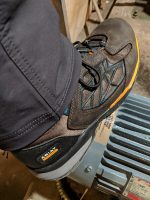
Summer vacations are winding down and the annual ritual for parents buying school supplies for the kids is underway, but maybe it’s high time to kick off the old work boots and find a new pair. Does that sound like a great first step?
Recently, Mechanical Hub ProStaff member Andy Mickelson, owner of Mickelson Plumbing and HVAC in Montana, tested a pair of Ariat Rebar Flex 6″ Waterproof Composite Toe Work Boots on multiple job sites and in various indoor/outdoor conditions to provide us with the following observations.
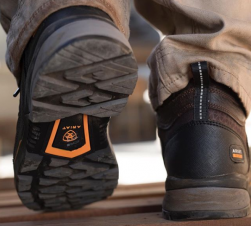 For those not familiar with the Ariat Work Boot Brand (most recognize the brand for its western boots), they have unique and tasteful designs while at the same time delivering high-quality performance and comfort in a stylish and fashionable boot.
For those not familiar with the Ariat Work Boot Brand (most recognize the brand for its western boots), they have unique and tasteful designs while at the same time delivering high-quality performance and comfort in a stylish and fashionable boot.
Ariat work boots are designed and engineered with the contractor and jobsite person in mind. Constructed from premium sturdy and durable leather with the most advanced footwear technologies they offer superior performance and on the job critical protection in any work field or the environment. Ariat boots offer a safety platform to match every environment, such as the Grip Strip Platform, the Work Ride Platform, the Expert Safety Clog Platform and the Safety Clog Platform.
Ariat also offers ATS and 4LR technology for comfort, stability, and traction as well as waterproof technology with the impermeable waterproof barrier. Insulated boots featuring Thinsulate Ultra insulation will help to give your feet the highest level of cold weather protection and while remaining a lightweight shoe. Ariat also offers a steel toe range for added safety. Ariat boots come with an oil, slip, heat, and abrasion resistant sole that will perform with the best grip and traction on any floor surface.
MICKELSON: It’s the first safety toe boot that I have comfortably worn throughout an entire work day in many years. For the past few months, I’ve worn them almost daily, sunrise to sundown, and in many cases hours into the night, on various surfaces without issue.
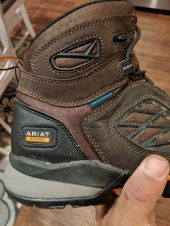 The Ariat Rebar work boots come out of the box ready to wear, with relatively little break in needed. The boots have a stylish design with a combination leather and mesh upper. The insole of the boot is comfortable with decent arch support. The soles are listed as a slip & oil resisting, debris release design. I’d support that statement having worn the boots through the better part of winter. Snow and parking lot slop stomps off easily. The tread pattern seems to grip well on most surfaces even when the temperatures drop well below zero.
The Ariat Rebar work boots come out of the box ready to wear, with relatively little break in needed. The boots have a stylish design with a combination leather and mesh upper. The insole of the boot is comfortable with decent arch support. The soles are listed as a slip & oil resisting, debris release design. I’d support that statement having worn the boots through the better part of winter. Snow and parking lot slop stomps off easily. The tread pattern seems to grip well on most surfaces even when the temperatures drop well below zero.
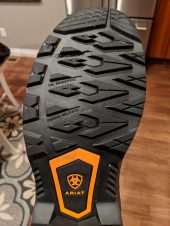 Many soles will begin to harden and become hazardous well before that, not the case with the Rebar. The debris release design comes in nice while constantly transitioning from snow covered ground onto finished concrete or similar smooth finishes. The uppers of the boot are leather and man-made materials, which lend to the boot breathing very well. Generally breathing well and waterproof aren’t generally both strong traits in a work boot, again, not the case with the Ariat Rebar.
Many soles will begin to harden and become hazardous well before that, not the case with the Rebar. The debris release design comes in nice while constantly transitioning from snow covered ground onto finished concrete or similar smooth finishes. The uppers of the boot are leather and man-made materials, which lend to the boot breathing very well. Generally breathing well and waterproof aren’t generally both strong traits in a work boot, again, not the case with the Ariat Rebar.
As a Professional Plumber and Pipefitter, these boots have been nearly submerged numerous times and thoroughly soaked on the exterior with no leakage regularly. The leather is holding up fairly well with normal daily abuse, resulting in small cuts and scrapes. The hardware on the boots consist of a single plastic rivet and webbing attachments below, holding a quality paracord like lace. Double row stitching has the components locked together.
Overall I look forward to wearing these boots for as long as they’ll last and very much looking towards to fulfill my work boot needs with Ariat in the future.
Work Boot Specs:
- Waterproof leather in key protection and support areas combined with rugged mesh panels
- 100% non-metallic
- Anatomical last for true fit
- Injected lateral support cage
- Forefoot flex notch
- Mesh lining
- EVA cushioning midsole
- ESS midsole in heel for extra protection and support
- Oil-and slip-resistant Duratread™ outsole with debris-release tread design
- Defined heel
- Safety toe is ASTM F2413-11 M/I/75 C/75 EH rated
- 4LR™ footbed for support and cushioning
For more on Ariat work boots and other work gear, visit Ariat Work.

As the HVAC industry evolves further in response to new market opportunities, sustainability initiatives and changing consumer demands it’s easy to be left at a loss of how to cut through the marketing speak and deliver benefit-driven information to your customers. Putting in the extra work to fully understand how to translate product features into Read more
As the HVAC industry evolves further in response to new market opportunities, sustainability initiatives and changing consumer demands it’s easy to be left at a loss of how to cut through the marketing speak and deliver benefit-driven information to your customers. Putting in the extra work to fully understand how to translate product features into real-world customer benefits will give you an edge in the market. Below is a discussion on how to navigate an industry of new and old considerations across customer demographics. Follow along to understand how you can shift your strategies to build customer relationships through simple communication training of your sales staff.
Define your competitive edge through no-nonsense delivery
Is it just me, or does every HVAC product on the market have the same features?
Tell me if you’ve heard this one before: “Our new, highly-efficient product provides homeowners with a simple, flexible, and cost-competitive solution.”
Does this sound like a product line you offer? Truth be told, this description could apply to any number of products. For example, a system that offers “zoning” could be anything from a sophisticated ductless system to a simple air conditioner with manual air dampers.
Here’s the problem: today’s customers are the most educated customer base we’ve ever experienced. With access to information at our literal fingertips in our smartphones, customers can fact-check a sales pitch in an instant. HVAC repair and replacement is an expensive investment for most customers to begin with, so it’s understood that they want to know exactly what they’re paying for.
If you state that a product is efficient, customers want to know: How efficient and what are the benefits? Compared to what? Does it cost more, if so, what’s the price difference? Do I really need it?
If you’re not being clear with your customers, you can trust that they are getting their information elsewhere — perhaps even pulling purchase decision information from your competition.
There are simple improvements to your sales information delivery that can help to move past the jargon and build meaningful conversations with your customers that leave them feeling well-informed and satisfied in their decision. In short, you can build credibility – and become the authority – by being honest and transparent.
As mentioned, using vague terms to describe a product as efficient, variable, or flexible tells the customer very little. The way to fix this is to always speak in terms of comparison. By speaking in comparisons, you will educate the customer on all of the options available to them – not just the one you’d like to sell. This is a critical step in achieving value in customer satisfaction.
If you’re not comfortable speaking in comparison, here are three ways to help get you started:
- Stop talking features & benefits and start talking sell points and personas
If you’re speaking to a customer about a solution they are just one step away in the sales funnel from making a purchase. It’s important at this stage that you carefully consider what you say and how you say it.
Consider this: most brochures you’ll hand a customer have a long list of features & benefits… those features are often phrased in comparison to an older version of that same product or directly to a competitor’s product – “Even quieter!” or “More flexible than ever!”
But the homeowner doesn’t care if it’s “even quieter” than a previous generation of a product that isn’t in the consideration set they are making for their home. Focus on the information your homeowner actually wants and needs: what options do you recommend; what specifically makes you recommend these based on my needs; how much does it cost?
Hone in on information by defining the sell points for all the products in your portfolio. An easy way to do this is to determine the five whys for each of your products:
- Who would most want or need to purchase this product?
- What type of situation is this product most suitable for?
- Why would they need this product?
- When can we promise to deliver this product to the customer?
- Where are most of the customers geographically located who need this product?
Notice the emphasis on the extremes in these questions. The goal is not to answer in general – “who could use or purchase this product” – but rather “who MOST wants or needs this product and why.” This is critical to defining the true selling points of a product.
By taking this approach, your team will be able clearly to describe the important reasons behind a recommendation because they have clear guidance as to why to recommend it in the first place. You might even consider building a questionnaire that will help both you and your customer come to a decision on the right choice for them.
- Group your product offerings using tiers
Instead of confusing customers with an onslaught of product brochures covered in brand names, shiny logos, and pretty pictures, consider packaging your products into tiers. Most homeowners are able to easily pick up the concept of Good, Better, and Best – or Bronze, Silver, and Gold.
By grouping your offering into rungs on a ladder, you’re giving the customer a baseline to compare products against one another. The key to this approach is to ensure your groupings offer key differences. Perhaps package A is best for the cost-conservative homeowner, package B is best for the energy-conscious customer, while package C is most suitable to the customer seeking a quick turnaround.
With this system, customers can easily determine the difference between your products and make informed decisions on which products best fit their needs.
-
Give three options whenever possible
When ordering drinks at your local coffee shop, why is it so many of us opt for the medium size? A small seems too small, and a large seems, well…too large. When we are given three options, often we are seeking the Goldilocks “just right” feeling.
No one wants to miss out on an upsell, but the goal should not be to dupe your customer into buying the highest-margin product by failing to tell them about a more cost-effective option that likely checks off the needs on their list. Provide customers with three options: something that doesn’t quite meet their needs, something that over-delivers, and a solution that falls in the middle. Because you have tuned in to exactly what the customer needs, selling the middle option in comparison to the other two should be simple.
If you are the service provider for all three options, this strategy gives you an added bonus. If the customer chooses the more elaborate option, you’ve earned more. If they choose the less desirable option, they will know up front what they’re getting and perhaps sacrificing – and you’ve earned their trust in the process.
What does this sound like?
The common – although tired – sales pitch I shared at the beginning turns into a richer conversation once you’ve added comparisons. In this example, I’ve uncovered that the customer is most concerned with the ability to stay comfortable in their home, with affordability being their second concern.
“The package I’d like to offer you today is our Premier package. Your upstairs and downstairs will have individual thermostats, which I know is what you were looking for. I’d like to share with you some other options for your consideration. Our Platinum package would give you even more comfort options: every room could have its own set point. The higher price could be offset with some rebates, but it is more expensive than the Premier package. Another option is our Economy package. This is the most affordable of the three, but it doesn’t come with the zoning you asked for. Given what we have discussed so far, I think the Premier package most meets your needs.”
By defining the sell points for your products, grouping them into tiers, and offering at least three options you can successfully provide the customer with a well-thought-out and easily understandable reasoning for your recommendation.
Resolve to make comparison-speak a habit in your organization and your customers will see you as a more trustworthy source of information for their buying decision process.

Pam Duffy, P.E. is the Owner of Spark One Solutions, LLC based in Dallas, TX – a marketing and business solutions consulting company based serving HVAC businesses.
She serves as a member of the AHR Expo Expert Council – a collaboration of HVACR experts and thought leaders launched by the AHR Expo in 2019 to educate and stimulate discussion concerning the biggest issues impacting the industry.
She has a mechanical engineering degree from the University of Central Florida and is a licensed PE. She has 10 years of experience in the HVAC industry and is most well-known for bringing new HVAC products to life.
Pam will be speaking more in-depth on this topic at AHR Expo 2020, and it will be a free session with attendee registration. Register HERE.
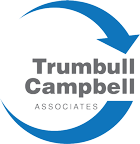
Panasonic, an industry-leading manufacturer of air conditioning, heating and indoor air quality systems, announces a new collaboration with Trumbull Campbell Associates, Inc., an independent manufacturers’ rep firm selling applied commercial heating, ventilation and air conditioning equipment and parts, to distribute Panasonic VRF equipment to its commercial customers in Eastern Massachusetts, Maine, New Hampshire and Rhode Island. As one Read more
Panasonic, an industry-leading manufacturer of air conditioning, heating and indoor air quality systems, announces a new collaboration with Trumbull Campbell Associates, Inc., an independent manufacturers’ rep firm selling applied commercial heating, ventilation and air conditioning equipment and parts, to distribute Panasonic VRF equipment to its commercial customers in Eastern Massachusetts, Maine, New Hampshire and Rhode Island.
 As one of New England’s most respected manufacturers’ rep firms, Trumbull Campbell provides sales, application and service support to customers across a variety of industries, including healthcare, biotech, hospitality, elderly care and higher education. Founded in 2006, Trumbull Campbell has delivered cost-effective end-to-end solutions to its customers, offering assistance with installation, design, and reliable products that address the complexity of maintaining an HVAC system.
As one of New England’s most respected manufacturers’ rep firms, Trumbull Campbell provides sales, application and service support to customers across a variety of industries, including healthcare, biotech, hospitality, elderly care and higher education. Founded in 2006, Trumbull Campbell has delivered cost-effective end-to-end solutions to its customers, offering assistance with installation, design, and reliable products that address the complexity of maintaining an HVAC system.
“We are grateful for the opportunity to represent a company not only of innovation and quality, but one of integrity,” said Tom Trumbull, Co-Founder, Trumbull Campbell Associates, Inc. “The level of support we’ve received from Panasonic is a true differentiator from other manufacturers. Our foothold in the territory paired with Panasonic’s brand and reputation offer a winning combination.”
“Trumbull Campbell is able to provide exceptional support for their customers in New England seeking applied equipment solutions,” said Nathan Oliver, Eastern U.S. Sales and Business Development Manager, Panasonic Appliances Air-Conditioning North America. “We are pleased to align with a company that can provide our customers with a personalized experience, satisfying their VRF application needs from design and selection to commissioning and service.”
For more information about Panasonic heating and air conditioning, please visit na.panasonic.com/us/home-and-building-solutions/heating-air-conditioning/.
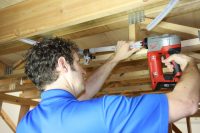
Residential plumbing and HVAC installers take note: you can pipe an entire home with the durability, flexibility and cost-effectiveness of PEX — for plumbing, fire sprinkler systems and radiant floor heating. Here’s how… PEX plumbing With more new homes plumbed with PEX than copper and CPVC combined, you’re probably already aware of the benefits of Read more
Residential plumbing and HVAC installers take note: you can pipe an entire home with the durability, flexibility and cost-effectiveness of PEX — for plumbing, fire sprinkler systems and radiant floor heating.
Here’s how…
PEX plumbing
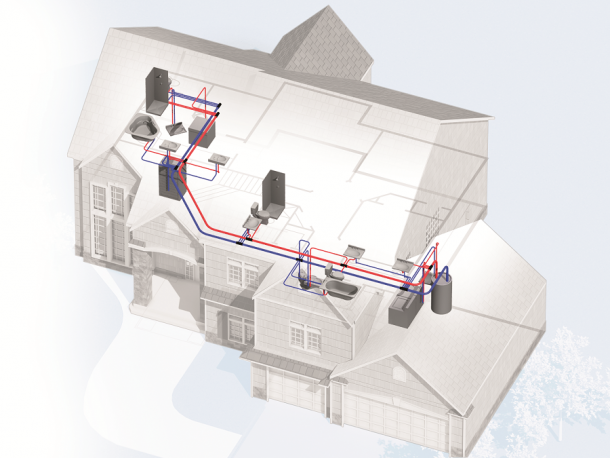 With more new homes plumbed with PEX than copper and CPVC combined, you’re probably already aware of the benefits of plumbing with PEX. However, you may not know about a newer, smarter way to install a PEX plumbing system that goes in faster, uses less materials, requires fewer connections and minimizes your liability.
With more new homes plumbed with PEX than copper and CPVC combined, you’re probably already aware of the benefits of plumbing with PEX. However, you may not know about a newer, smarter way to install a PEX plumbing system that goes in faster, uses less materials, requires fewer connections and minimizes your liability.
This innovative design is called Logic plumbing.
The Logic approach uses the flexibility of PEX pipe to minimize connections and reduce potential leak points while also incorporating multiport tees located near fixture groupings to limit the amount of pipe and connections needed.
What’s a multiport tee, you ask? It’s essentially a bunch of tees all molded together to create one long tee with multiple outlets. This design greatly reduces the number of fittings and connections needed to plumb a home (think: reduced materials cost and labor time).
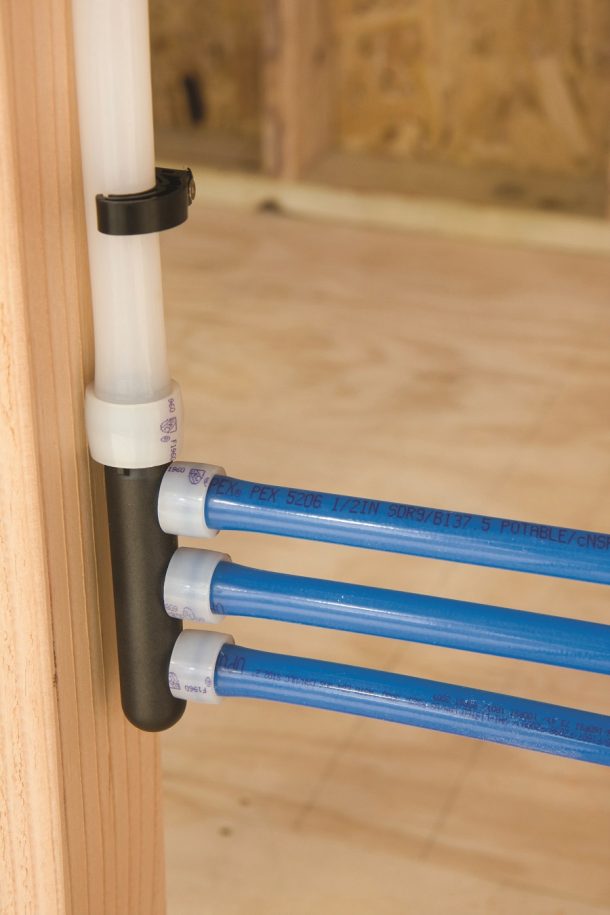 Here’s an example of how a multiport tee saves installation time and materials: a flow-through multiport tee with six outlets has eight connections (six connections for the ports, a main flow-through inlet and a main flow-through outlet). Six regular tees, on the other hand, have a whopping 18 connections. That’s an increase of more than double the connections — and double the installation time.
Here’s an example of how a multiport tee saves installation time and materials: a flow-through multiport tee with six outlets has eight connections (six connections for the ports, a main flow-through inlet and a main flow-through outlet). Six regular tees, on the other hand, have a whopping 18 connections. That’s an increase of more than double the connections — and double the installation time.
Best of all, multiport tees are not considered manifolds, so they can be installed behind walls without the need for an access panel. Double win, there!
For a Logic layout, a main line connects to a multiport tee with distribution lines going out from the multiport to provide water to all fixtures in a single or adjacent grouping. This design uses significantly less pipe than a home-run layout, with just a few more connections. Plus, it requires considerably fewer connections compared to a trunk-and-branch installation.
For example, a 2,300-square-foot, two-story home using a Logic design requires only 637 feet of pipe while a home-run system uses 1,515 feet of pipe. And, while it’s true a Logic installation uses slightly more connections than a home-run layout (59 vs. 48 in the 2,300-square-foot, two-story home example), the amount of pipe savings is significantly more beneficial with the labor and material savings you get with less pipe to install.
A Logic layout also installs much faster compared to a trunk-and-branch system due to the vast reduction in connections. With the two-story home example, a Logic layout uses a mere 16 fittings and 59 connections compared to a whopping 96 fittings and 165 connections for trunk and branch.
PEX multipurpose fire sprinkler systems
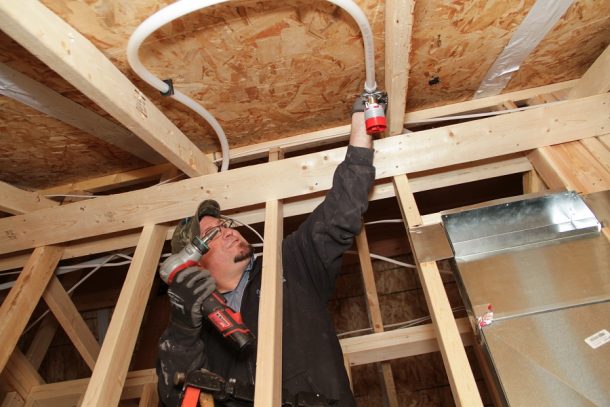 If you’re a licensed plumber who wants to add an additional service to your offering, check out PEX multipurpose fire sprinkler systems. These systems combine the fire sprinklers with a home’s cold-water plumbing. It’s genius!
If you’re a licensed plumber who wants to add an additional service to your offering, check out PEX multipurpose fire sprinkler systems. These systems combine the fire sprinklers with a home’s cold-water plumbing. It’s genius!
Installation is remarkably easy — the sprinkler is essentially just another fixture to tie into the plumbing line. For most contractors who already install PEX plumbing systems and have the tools, knowledge and, most importantly, the relationships with the home builders, this is a slam dunk.
Depending on the jurisdiction, multipurpose systems typically don’t need check valves or backflow preventers, and because they combine with the potable plumbing, they don’t use antifreeze, so all those added costs are eliminated.
To get started in most jurisdictions, licensed plumbers just need the appropriate training and a quality design that meets the NFPA 13D standard requirements for home fire sprinkler systems.
If you’re interested in learning more, email me at kim.bliss@uponor.com, and I can get you all the information you need to add this profitable new service to your business.
PEX hydronic radiant floor heating
There’s nothing like the comfort of radiant floor heating — ask anyone who has experienced it. And, homeowners will pay nicely for a quality radiant floor heating system, so there is definitely income potential if you can learn to do it right.
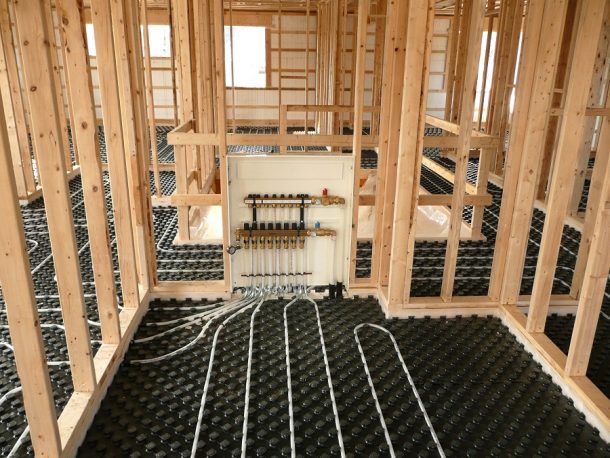 That said, with radiant floor heating, there’s a little more to learn. But, like fire sprinkler systems, starting with a proper design is key. If your design is wrong in the beginning, there’s not much you can do to fix the system once it’s installed.
That said, with radiant floor heating, there’s a little more to learn. But, like fire sprinkler systems, starting with a proper design is key. If your design is wrong in the beginning, there’s not much you can do to fix the system once it’s installed.
Take advantage of the radiant design services many PEX manufacturers offer to guide you through the process. There are several design factors to know, including floor R-values, heat-loss calculations, pipe sizing, loop lengths, pump sizing, manifold types and more.
Once you learn the basics of radiant design and get a few small jobs under your belt, you have the potential to take your expertise to the next level with bigger, more profitable projects. But again, be sure to get the proper design and training before you tackle a radiant project. It will be well worth it in the long run.
To get a jumpstart on all things radiant, visit the following industry websites at radiantprofessionalsalliance.org, healthyheating.com or heatinghelp.com.

Kim Bliss is the content development manager at Uponor. She can be reached at kim.bliss@uponor.com.
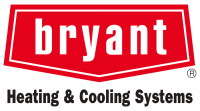
During the recent Bryant Dealer Rally, the company’s annual meeting where its top dealers are honored, Air Tech Heating, Inc. of Fond du Lac, Wisconsin was named Bryant Dealer of the Year, the highest honor a Bryant dealer can receive. Each year, this award recognizes the company whose hard work, expertise and business acumen have Read more
 During the recent Bryant Dealer Rally, the company’s annual meeting where its top dealers are honored, Air Tech Heating, Inc. of Fond du Lac, Wisconsin was named Bryant Dealer of the Year, the highest honor a Bryant dealer can receive. Each year, this award recognizes the company whose hard work, expertise and business acumen have helped them to stand out as a leader in the industry. Bryant, a national supplier of heating, ventilating and air-conditioning (HVAC) equipment, is a part of Carrier, a leading global provider of innovative HVAC, refrigeration, fire, security and building automation technologies.
During the recent Bryant Dealer Rally, the company’s annual meeting where its top dealers are honored, Air Tech Heating, Inc. of Fond du Lac, Wisconsin was named Bryant Dealer of the Year, the highest honor a Bryant dealer can receive. Each year, this award recognizes the company whose hard work, expertise and business acumen have helped them to stand out as a leader in the industry. Bryant, a national supplier of heating, ventilating and air-conditioning (HVAC) equipment, is a part of Carrier, a leading global provider of innovative HVAC, refrigeration, fire, security and building automation technologies.
“We’re both honored and humbled to be selected as the 2019 Bryant Dealer of the Year,” said Dan Price, owner, Air Tech Heating, Inc. “I’m incredibly proud of the entire team at Air Tech and I appreciate being recognized for doing business our way, with honesty and integrity. We’re proud to be a Bryant Factory Authorized Dealer and have the support of such a great company. I’m also grateful for the amazing relationships we’ve built with both Bryant and our distributor, Auer Steel, over the course of my 22 years owning the business.”
Founded in 1997, Air Tech Heating, Inc. has become known as the “Best Heating & Air Conditioning Company in the Fond du Lac Area” for ten straight years by Gannett Readers’ Choice. In 2018, Price’s son, Jim, and his wife, Sarah, became co-owners of Air Tech Heating, Inc. ensuring that it will remain a fixture in the community for years to come. It’s even more fitting that Air Tech Heating, Inc. was selected as the 2019 Bryant Dealer of the Year, as Price retired shortly after the Dealer Rally.
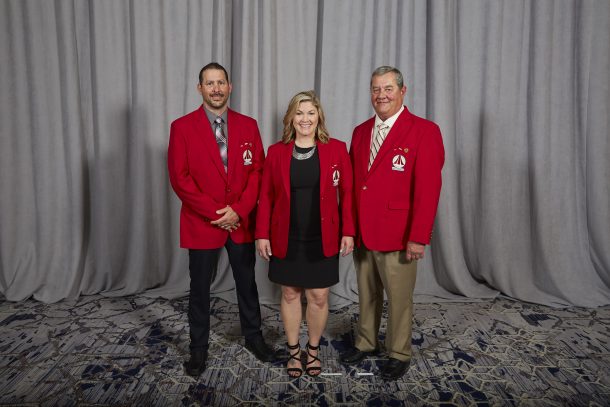
Air Tech Heating, Inc. of Fond du Lac, Wisconsin was named Bryant Dealer of the Year. From left to right are Jim Price, Sarah Price, and Dan Price of Air Tech Heating.
“Bryant dealers continue to help set the standard in our industry,” said Matthew Pine, president, Residential HVAC, Bryant. “Our 2019 Dealer of the Year, Air Tech Heating, Inc. is an exemplary organization and has risen to the top among the very best in our elite group of dealers. Dan and his team serve as ideal examples for other Bryant dealers of how to run a successful business and do ‘Whatever It Takes’ to care for our customers.”
Bryant selected its 2019 Dealer of the Year from 22 Medal of Excellence winners, comprised of Bryant Factory Authorized Dealers from throughout North America. The candidates were judged on overall sales growth, high-efficiency and indoor air quality equipment sales, customer satisfaction and participation in dealer programs and promotions.
The 2019 Medal of Excellence Winners include:
- Affordable Heating and Air Conditioning, Inc. – Cudahy, Wisconsin
- AGS HVAC Services – Westport, Massachusetts
- Air Tech Heating, Inc. – Fond du Lac, Wisconsin
- Bennett Heating and Air – Purvis, Mississippi
- Bob’s Heating & Air Conditioning – Woodinville, Washington
- Chadds Ford Climate Control – Chadds Ford, Pennsylvania
- Chapman Heating, Air Conditioning & Plumbing – Indianapolis, Indiana
- Chris Mechanical Services, Inc. – West Chicago, Illinois
- Cosby Heating – Mount Vernon, Ohio
- Dave’s Heating & Air – Lincoln, Nebraska
- Design Air, Inc. – Missoula, Montana
- Evergreen Gas, Inc. – Sherwood, Oregon
- Family Heating and Air – Pensacola, Florida
- Federal Elite Heating & Cooling, Inc. – Dresden, Ohio
- Fort Collins Heating & Air – Fort Collins, Colorado
- GAC Services – Gaithersburg, Maryland
- Gainesville Mechanical, Inc. – Gainesville, Georgia
- Haley Comfort Systems – Rochester, Minnesota
- IERNA’S Heating & Cooling, Inc. – Lutz, Florida
- Precision Heating & A/C – Twin Falls, Idaho
- Regal, Inc. – York, Pennsylvania
- Waychoffs Heating & A/C – Jacksonville, Florida
In addition to the Dealer of the Year award, Bryant named Peck & Weis Heating, Cooling, Plumbing & Electric of Lake Geneva, Wisconsin as this year’s recipient of the Charles Bryant Award. The Charles Bryant Award, named in honor of the company’s founder, recognizes a loyal Bryant Factory Authorized Dealer (FAD) that epitomizes the characteristics of Charles Bryant, including professionalism, quality, reliability and community spirit.
For more information about Bryant and to find a dealer near you, visit www.bryant.com.
